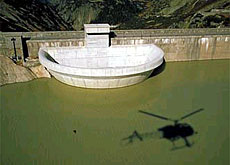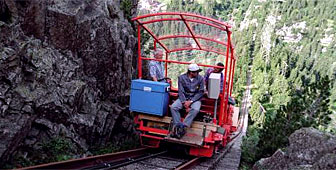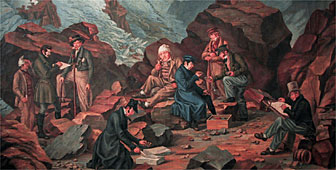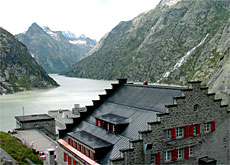High voltage tourism generated on Grimsel Pass

The dams on the Grimsel Pass have been providing Swiss households with hydroelectric power for decades.
They are also becoming a tourist attraction, revealing to visitors the wonders of technology and the environment it has eternally altered.
The mountain guide and teacher, Emil Feuz, is responsible for the latest attraction on the Grimsel Pass.
It is a backpack, containing an odd assortment of tools, maps and bits and pieces that I would have suspected Feuz of scavenging from a building site if I did not know better: a solitary nail, a piece of hard rubber tubing and a tin can.
Nail and tin can
But there is method in his madness. The backpack also contains a manual packed full of suggestions on how best to deploy the hammer, chisel and magnifying glass, as well as the nail, tubing and tin can while exploring the “Parcours du Glacier” trail.
The trail leads from the Hotel Grimsel Hospiz on the pass to the Lower Aar Glacier and the backpack is the one essential piece of equipment hikers should take along if they want to better understand the geology, glaciology and climatology of the area.
The backpack can be picked up at the hotel for a day or several days.
Feuz demonstrates how the hammer and chisel can be used to break apart rocks in order to get a closer look at their composition, and explains various experiments that can be done on the glacier.
Hikers are also encouraged to use the pencil crayons and sketch paper to draw the manmade alterations to the landscape.
Alpine peaks
“I learned to appreciate the environment here when we fought [successfully] against the gigantic hydroelectric project,” says Feuz, looking out over the dammed lake and the high alpine peaks rising above it.
The plans called for the construction of new dams on and around the pass but were eventually shelved due to the strong opposition.
“It’s important for other people to see that man shouldn’t be allowed to do anything he wants to the environment.”
Hydroelectric tourism
Another kind of tourism takes place a few hundred metres directly below the trail in a labyrinth of tunnels and manmade caverns.
This is where tour groups are taken to see the giant hydroelectric turbines, each capable of converting 20,000 litres of water a second into energy.
“We could fill a modern bus with water every second with that much volume,” says Peter Baumberger proudly.
As head of communications for the hydroelectric company, Grimsel Power, Baumberger is responsible for promoting tourism on the Grimsel Pass as part of the company’s high-profile public relations campaign.
The company has long owned three of the hotels in the area and given tours of its plants, but it is now offering hikes and excursions combining the wonders of hydroelectric power and the natural environment.
Grimsel Power is even promoting the discovery trek of Emil Feuz, despite the fact that Feuz was a vocal opponent of the company’s expansion plans.
Environmental lobby
But Baumberger says it is better to work with than against the main environmental lobby group, “Grimselverein”, which led the campaign opposing the construction of new dams.
And Baumberger says Grimsel Power is listening closely to the lobby’s concerns about its more modest plans which would include increasing the height of the walls of the existing dams by 23 metres in order to flood more land.
The environmentalists have to weigh up the advantages and disadvantages,” says Baumberger, above the roar of the turbines.
“What is more important for our future?” he asks rhetorically. “Shouldn’t we promote hydroelectricity along with other renewable energy sources like wind and solar power?”
Baumberger says in winter, Switzerland has to import electricity from abroad to meet its energy needs and most of this comes from polluting coal and gas-fired power plants.
As part of the underground tour, Baumberger explains how the turbines can be run in reverse to pump excess water back up from one artificial lake to another.
And he runs his hand over a cross-section map of the region showing the extent of the reservoirs, high-pressure shafts and turbine plants.
The water from the upper dams drops through the series of shafts and pipes 1.5 kilometres in altitude creating a force equal to the power of 2,000 Formula One race cars revving their engines all at once – but, as Baumberger boasts – hydroelectricity produces no harmful emissions.
Clean electricity
He adds that if Grimsel Power is allowed to raise the walls of its dams, then Switzerland will be able to produce more clean electricity during peak periods in winter, and lessen its dependence on dirty energy from abroad.
It’s a price that Emil Feuz and the Grimselverein are not necessarily willing to pay.
As he puts the nail, rubber tubing and tin can back in his bag, Feuz says “Nothing could be less alive than an empty dam which is the case in spring when all the water has been used up. It’s death personified.”
He says there are other considerations as well. “Never a thought is given to how electricity is produced, or how much,” he says. “Do we really need more?”
swissinfo, Dale Bechtel, Grimsel Pass
Hydroelectricity accounts for nearly 60 per cent of all energy produced in Switzerland.
The first dams on the Grimsel Pass were built in the 1920s.
Grimsel Power produces 2,000 GWh of hydroelectricity annually, which accounts for about three per cent of Switzerland’s total energy output.
The hydroelectricity company, Grimsel Power is stepping up the promotion of tourism on the Grimsel Pass as part of its public relations campaign.
It is even supporting tourism projects created by environmental groups who successfully fought against a project to build more dams.
One of these projects involves a hike with a backpack-for-hire containing tools and guides for exploring the natural environment.
The environmentalists are in discussion with Grimsel Power over new more modest plans to raise the height of the dams in order to flood more land.

In compliance with the JTI standards
More: SWI swissinfo.ch certified by the Journalism Trust Initiative




You can find an overview of ongoing debates with our journalists here. Please join us!
If you want to start a conversation about a topic raised in this article or want to report factual errors, email us at english@swissinfo.ch.